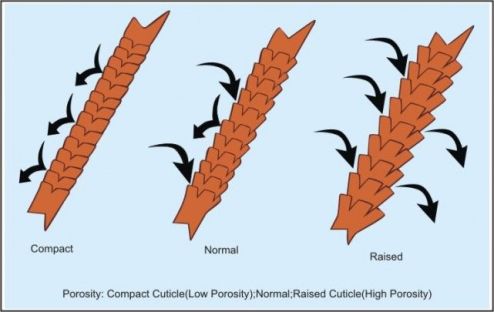Knowing your hair’s porosity will change your life! It’s one of the most simple concepts necessary for all naturals or to-be-naturals to know, yet it’s not as talked about as much as hair type is (you know, the 3A, 3B, 3C, 4A, 4B, 4C). Natural hair type doesn’t tell us nearly as much about what our hair needs as porosity does.
Hair type doesn’t tell you which moisturizing oils are best, which conditioners are best, which deep treatments are best etc. Two people can have the 4C hair type, but may need COMPLETELY different hair products for their hair. You can’t look at a YouTuber or Blogger and grab the products they’re using right away without knowing their porosity. So, as you can now figure, this is very important homies.
What exactly is hair porosity?
Porosity is your hair’s ability to absorb and retain moisture
So what’s the big deal? Well, in order to grow healthy (and long) hair that is less prone to dryness which leads to breakage, you need what…drum roll….PROPERLY MOISTURIZED HAIR. This is especially for natural black hair. In order to properly moisturize hair you need to make sure you not only ADD moisture to your hair but that it is actually RETAINED i.e. your hair keeps the moisture locked in.
There are 3 different hair porosity ‘levels’. Low, normal, and high.

Low Porosity
Hair cuticles on low porosity hair are closed and so moisture does not enter easily. A quick sign for low porosity hair is products that feel as though they are just sitting on your hair and not absorbed. See test below to figure out if this is you!
Key tips:
- Use heat to open up the cuticles to let the moisture in. How, well, warm water washes, and warm deep conditioning sessions. Simple! Use a deep conditioning cap or home hooded dryer to create warmth for your deep conditions and/or treatments.
- Make sure to still close the cuticles after a warm wash by rinsing with cool water.
- Deep condition every wash day
- Invest in a satin cap for sleeping
- Best oils or products for low porosity hair: Light oils are best, such as coconut oil, sweet almond oil, grapeseed oil, jojoba oil, avocado oil.
- Ease up on the products, your hair is prone to build up so don’t layer on product on top of product.
- Low porosity hair is protein sensitive. Avoid using a lot of protein on your hair, those protein treatments that look really good? Nah, not for you. Unless really necessary once or twice a year. Stick to moisture treatments.
Normal Porosity
This one is porosity goals really! You hair is not problematic. It absorbs and retains moisture well and you don’t really have a problem with dryness – unless you leave the hair for dead of course 😀 It’s obvious you still got to take care of it.
High Porosity
As you can see in the image above, high porosity hair has cuticles that are lifted and so absorbs moisture quickly but also looses it quickly. Some end up with high porosity after heat or chemical damage to their hair. Signs of high porosity hair are things like finding that your hair dries really quickly after washes or moisturizer, looks dull and feels especially dry.
Key tips:
- Protein treatments are great – doing one once a month will do you some good!
- Deep condition more often, bi-weekly is advised.
- Make sure to still close the cuticles after by rinsing your washes with cool water.
- Use leave-in conditioners and heavier products like butters to seal the moisture in.
- Best oils/ or products for high porosity hair: Olive oil, Castor Oil, Shea Butter, Hemp-seed oil, coconut oil.
- Rinse with Apple Cider Vinegar to flatten the cuticle and seal the moisture in.
- Aloe Vera Gel or Juice is also great – on it’s own or added to your leave-in conditioner.
- Avoid using heat on your hair and excessive coloring.
So wait, how do you find out what your hair porosity is!!!? Simple really.
HAIR POROSITY TEST
- Grab a tall glass of water
- Extract a strand of hair from your head – must use clean hair. Hair with product is said to possibly alter results.
- Drop this strand inside the water and watch it for a minute or two.
Results:
Ideally, hair should absorb moisture at a slow pace. The rate at which the hair sinks is basically indicative of the rate at which it absorbs moisture. The faster the hair absorbs moisture, the more porous it is. In other words, if it sinks to the bottom quickly, the cuticles are open and absorb lots of moisture immediately. If the hair floats, the cuticles are shut and are not letting the moisture in.
- Low Porosity hair will float at the top of the glass
- Medium porosity will slowly sink and be about halfway through the glass when you check in a minute.
- High Porosity will have sunk to/near the bottom of the glass.
Once you know this, you may find that you have been moisturizing correctly by chance, or from intuition and knowing what works for your hair. Otherwise, if you’ve been having problems with your hair, then you’ll have to adjust your hair regimen accordingly to suit your hair’s porosity.
P.S. I have low porosity.
So, what;s your hair porosity? Share with me & other readers in the comments and let us know what has or hasn’t worked for you! Got questions? Let me know. You already know.































